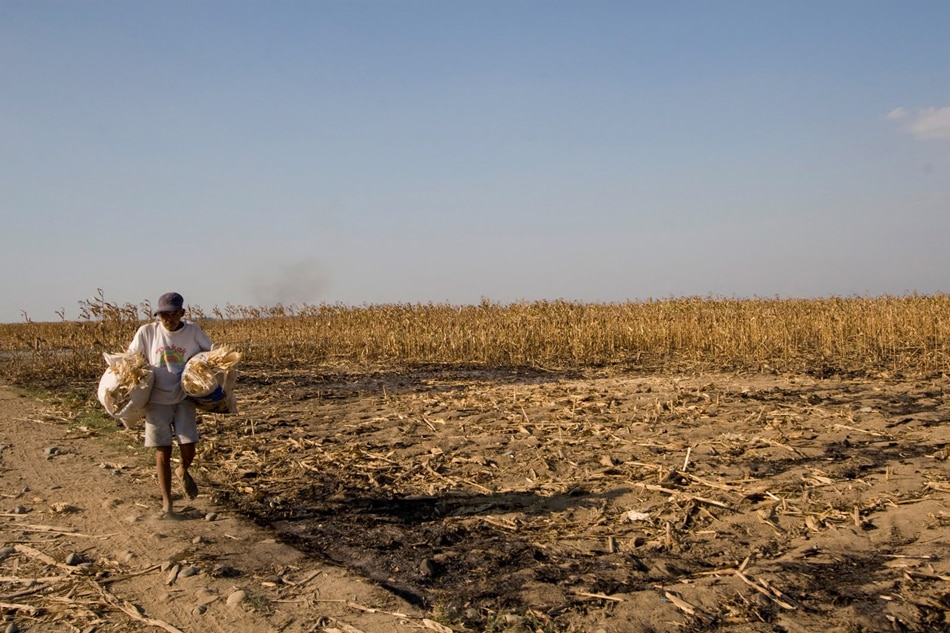2023 only 11th hottest year in Philippines: PAGASA
ADVERTISEMENT

Welcome, Kapamilya! We use cookies to improve your browsing experience. Continuing to use this site means you agree to our use of cookies. Tell me more!
2023 only 11th hottest year in Philippines: PAGASA
Ariel Rojas,
ABS-CBN News
Published Jan 11, 2024 03:24 PM PHT
MANILA — While 2023 was declared as the hottest year on record globally by the EU climate monitors, it is only the 11th warmest in the Philippines, based on the initial assessment of state weather bureau PAGASA.
Ana Liza Solis, chief of PAGASA's Climate Monitoring and Prediction Section, attributes this to the occurrence of El Niño during the second half of the year.
"'Yung contribution ng warmest record natin last 2023 is during the second half. Hindi pa natin masyadong naramdaman or na-feel yung talagang mainit na temperatura na dulot nitong El Niño," she said.
However, since the peak of El Niño will coincide with the country's dry season from March to May, this may lead to hotter temperatures being recorded this year.
MANILA — While 2023 was declared as the hottest year on record globally by the EU climate monitors, it is only the 11th warmest in the Philippines, based on the initial assessment of state weather bureau PAGASA.
Ana Liza Solis, chief of PAGASA's Climate Monitoring and Prediction Section, attributes this to the occurrence of El Niño during the second half of the year.
"'Yung contribution ng warmest record natin last 2023 is during the second half. Hindi pa natin masyadong naramdaman or na-feel yung talagang mainit na temperatura na dulot nitong El Niño," she said.
However, since the peak of El Niño will coincide with the country's dry season from March to May, this may lead to hotter temperatures being recorded this year.
"Potential talaga siya na it could be one of the warmest years on record din natin, itong 2024, dahil papasok na tayo doon sa tinatawag na peak impact sa atin ng El Niño, in terms of mas mainit na temperatura, kasama pa yung alinsangan, and also yung malaking reduction sa tubig-ulan," Solis said.
The year 1998 topped the list of warmest years in the country, with an annual average temperature of 28.29 degrees C.
The other years in the top three include 2016 at 28.16°C and 2010 at 28.06°C. 2023 averaged 27.8°C.
The list was compiled from averaging the recorded temperatures in an entire year in the PAGASA weather stations across the country.
Solis noted that while the past years saw an increasing trend in temperatures brought by the prevailing climate change, the warming is more noticeable at nighttime.
"Kung titingnan natin yung maximum and minimum - 'yung daytime at nighttime temperature, doon natin mas makikita na medyo baka mas umiinit ang ating nighttime temperature. 'Yung nighttime temperature natin ang mabilis ang trend ng pag-increase ng temperature," she said.
Climate scientists point to El Niño and climate change as the cause of the record-breaking heat in 2023.
Eight of the ten warmest years in the country were El Niño years. Only 2020 and 2021 were La Niña years.
EL NIÑO AND CLIMATE CHANGE
The impacts of El Niño, a natural climate pattern observed in changes in wind direction and sea surface temperatures in the tropical Pacific Ocean, are said to be exacerbated by human-induced climate change.
In the Philippines, Solis noted an observed change in the frequency and intensity of tropical cyclones over the past decades.
"In terms of bagyo, meron s'yang decreasing trend in the number of tropical cyclones, yung frequency. Pero in terms of intensity, 'yung mas malalakas ang hangin, more than 185 kph, 'yun 'yung medyo mas dumadami," she said.
In 2023, only 11 storms formed inside or entered the Philippine area of responsibility, tying 1998 and 2010 - both El Niño years - as the years with the fewest storms.
"Potential talaga siya na it could be one of the warmest years on record din natin, itong 2024, dahil papasok na tayo doon sa tinatawag na peak impact sa atin ng El Niño, in terms of mas mainit na temperatura, kasama pa yung alinsangan, and also yung malaking reduction sa tubig-ulan," Solis said.
The year 1998 topped the list of warmest years in the country, with an annual average temperature of 28.29 degrees C.
The other years in the top three include 2016 at 28.16°C and 2010 at 28.06°C. 2023 averaged 27.8°C.
The list was compiled from averaging the recorded temperatures in an entire year in the PAGASA weather stations across the country.
Solis noted that while the past years saw an increasing trend in temperatures brought by the prevailing climate change, the warming is more noticeable at nighttime.
"Kung titingnan natin yung maximum and minimum - 'yung daytime at nighttime temperature, doon natin mas makikita na medyo baka mas umiinit ang ating nighttime temperature. 'Yung nighttime temperature natin ang mabilis ang trend ng pag-increase ng temperature," she said.
Climate scientists point to El Niño and climate change as the cause of the record-breaking heat in 2023.
Eight of the ten warmest years in the country were El Niño years. Only 2020 and 2021 were La Niña years.
EL NIÑO AND CLIMATE CHANGE
The impacts of El Niño, a natural climate pattern observed in changes in wind direction and sea surface temperatures in the tropical Pacific Ocean, are said to be exacerbated by human-induced climate change.
In the Philippines, Solis noted an observed change in the frequency and intensity of tropical cyclones over the past decades.
"In terms of bagyo, meron s'yang decreasing trend in the number of tropical cyclones, yung frequency. Pero in terms of intensity, 'yung mas malalakas ang hangin, more than 185 kph, 'yun 'yung medyo mas dumadami," she said.
In 2023, only 11 storms formed inside or entered the Philippine area of responsibility, tying 1998 and 2010 - both El Niño years - as the years with the fewest storms.
However, in terms of rainfall, there is no observed trend across the country, PAGASA said.
"Base sa initial assessment natin, during the past three years, medyo madami ang ating mga ulan lalong-lalo na during the Amihan season. Makikita rin natin may mga areas na decreasing rin 'yung trend dun sa rainfall, especially sa mga areas sa Luzon. May mga areas din sa Visayas and Mindanao na both increasing and decreasing 'yung trend sa rainfall distribution," Solis said.
MOST VULNERABLE SECTORS
Solis identified water and food security, health, energy, and public safety as the sectors most vulnerable to climate change, in the Philippines at least.
She highlighted the impacts of the warming temperatures on human health and agriculture.
"Hindi lang 'yung indibidwal na tao, hindi lang 'yung human discomfort natin, as well as yung mga spread ng mga vector-borne diseases, as well as 'yung mga poultry and livestock kaya apektado rin yung agriculture sector, including the aquaculture, kasi medyo sensitive din sila sa mainit na temperatura," she said.
Solis believes farmers should be strategic in planning their crop seasons to adjust to the changing climate.
"I think this would be an opportunity dun sa mga nagtatanim, mga farmers but then strategic din dapat siyempre 'yung pagpaplano na kung saan may mga better opportunity na magtanim na hindi nangangailangan ng kaunting tubig 'yun 'yung dapat magiging masigasig 'yung ating mga magsasaka na magtanim," Solis said.
However, in terms of rainfall, there is no observed trend across the country, PAGASA said.
"Base sa initial assessment natin, during the past three years, medyo madami ang ating mga ulan lalong-lalo na during the Amihan season. Makikita rin natin may mga areas na decreasing rin 'yung trend dun sa rainfall, especially sa mga areas sa Luzon. May mga areas din sa Visayas and Mindanao na both increasing and decreasing 'yung trend sa rainfall distribution," Solis said.
MOST VULNERABLE SECTORS
Solis identified water and food security, health, energy, and public safety as the sectors most vulnerable to climate change, in the Philippines at least.
She highlighted the impacts of the warming temperatures on human health and agriculture.
"Hindi lang 'yung indibidwal na tao, hindi lang 'yung human discomfort natin, as well as yung mga spread ng mga vector-borne diseases, as well as 'yung mga poultry and livestock kaya apektado rin yung agriculture sector, including the aquaculture, kasi medyo sensitive din sila sa mainit na temperatura," she said.
Solis believes farmers should be strategic in planning their crop seasons to adjust to the changing climate.
"I think this would be an opportunity dun sa mga nagtatanim, mga farmers but then strategic din dapat siyempre 'yung pagpaplano na kung saan may mga better opportunity na magtanim na hindi nangangailangan ng kaunting tubig 'yun 'yung dapat magiging masigasig 'yung ating mga magsasaka na magtanim," Solis said.
"And then sa iba naman na hindi sapat yung tubig nila, so 'eto yung medyo kailangang pagplanuhan ng ating agriculture sector," she continued.
While the water supply from the Angat Dam may be enough to tide Metro Manila over through the dry season, Solis worries that it may not last if dry conditions drag on.
"Ang very challenging din dito is kung mag-prolong 'yung dry season, kung ma-delay 'yung onset ng rainy season dahil meron tayong lag effect nitong El Niño," she said.
"And then sa iba naman na hindi sapat yung tubig nila, so 'eto yung medyo kailangang pagplanuhan ng ating agriculture sector," she continued.
While the water supply from the Angat Dam may be enough to tide Metro Manila over through the dry season, Solis worries that it may not last if dry conditions drag on.
"Ang very challenging din dito is kung mag-prolong 'yung dry season, kung ma-delay 'yung onset ng rainy season dahil meron tayong lag effect nitong El Niño," she said.
ADVERTISEMENT
ADVERTISEMENT
ADVERTISEMENT



